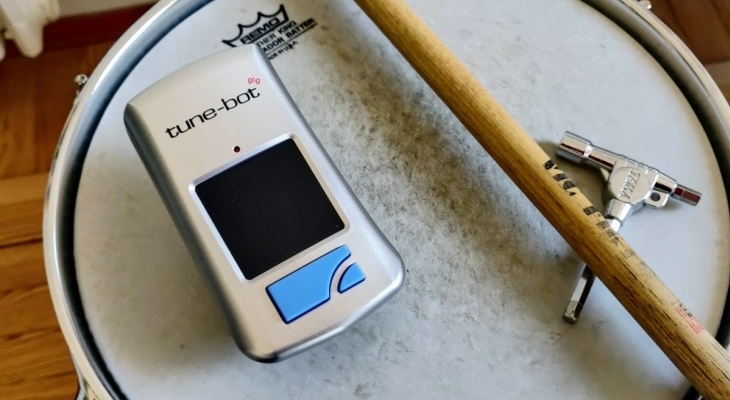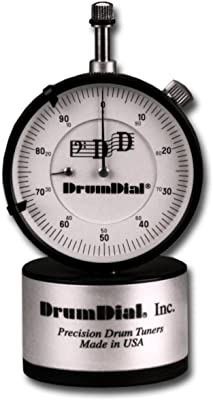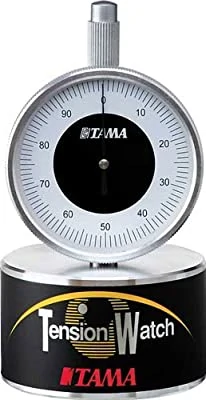Tuning your drums is a process that some drummers love while other drummers hate. Many people have an ear for it. They can sit and hear when all the right tones are being produced.
Then you get drummers like me who are absolutely terrible at it and find tuning drums to be a difficult process. Thankfully, companies produce these things called drum tuners that do all the hard work for us.
So, let’s check out some of the best drum tuners on offer.
Best Drum Tuners for the Money - My Favorites
The Tune-Bot is one of the most popular drum tuners on the market. When someone is struggling to tune drums, people will often just resort to the phrase of “just getting a tune-bot”.
So, what makes this thing so popular? Firstly, it’s incredibly easy to use. The interface is simple to navigate through and you’ll figure out how to do everything with a few minutes of experimentation.
It will help you get an even tension across the drum, creating the best drum tone possible. It checks the tones of your drums. It has a fantastic range of frequency options, allowing you to work easily with very deep bass drums as well as high-pitched snares and toms.
It even allows you to tune your drums to certain pitches. A great feature for those drummers that are musically inclined. The Difference and Modes provide some variety and accuracy to boot.
You can save 5 kit presets with up to 10 drums. This means you can take your kit to the gig and tune it to sound the exact same way it sounded in your practice room.
The Tune-Bot is best suited for drummers that want to assign pitches to their drums. If you just need something to check tensions, it may be a bit pricey, considering most people are least likely to using all of its features.
One of my favorite things about the Tune-Bot is that the company has a website that provides a bunch of helpful information. I’ve often looked on there to watch a few tutorials and check out the section where they show what settings certain drummers use.
Seeing what settings other drummers use is a great way to find some inspiration or perhaps get similar sounds to what they have. I lean more on the side of getting inspiration as I’m a huge advocate of developing your own sound on the drums. Using this particular tuner along with all the available resources is a great way to do that.
I found the batteries to run down pretty quickly on the Tune-Bot. So, you’ll need to have spare batteries with you at all times. It’s best to keep them in your stick bag.
PROS
CONS
2. DrumDial
The DrumDial is a strong contender to the Tune-Bot. The difference is that the DrumDial offers a more mechanic approach. It measures the pressure of drum heads and reflects the tightness on a dial.
This system is fantastic for people who don’t want to put too much trust into technology. Imagine that you need to tune your kit just before a gig and your batteries die in your drum tuner. That’ll never happen with the DrumDial!
The pressure gauge is extremely easy to read. If you’re used to measuring food in the kitchen, you’ll feel right at home with the DrumDial measurements. A great feature is that it can lock in on a certain measurement, allowing you to compare different parts of the drum head to that measurement.
A great thing about this tuner is that you don’t need to know anything about tuning drums or pitches. You just need to make sure that all the tensions around the lugs are the same and your drum kit will sound beautiful.
You just need to be careful when handling the DrumDial as it has the potential to damage your drum heads. The pressure measuring tip at the bottom tends to leave marks on thinner heads (here's how to clean drum heads).
While the mechanical nature of this tuner may be more attractive to some people, I found it to be heavier than all the electronic drum tuners. It’s not something I would keep in my stick bag as it would weigh it down a fair amount. Instead, it’s easier to keep in a backpack that has a bit more support.
Something unique about this is that you can use it to tune electronic drums that have mesh heads. You’re not tuning them to sound different. Instead, you’re just tuning them to feel as even as they can so that they feel great to play on.
Since the other tuners are digital, they don’t work as well with mesh heads. The DrumDial has worked the best because it’s mechanical. I haven’t heard many people speak about this use for the DrumDial, but it’s definitely something to consider!
PROS
CONS
3. Tama TW100
The Tama TW100 essentially works the same as the DrumDial. It’s a fairly large tuner that sits on the edge of the head to read the tension. Once you decide what tension to use, you can adjust the tension at every lug to get a well-tuned drum.
Tama is one of the leading drum manufacturers in the world. All the kits sound immaculate and are well-produced to deliver consistent tones. The fact that this tuner has Tama’s name in front of it kind of guarantees you that it will produce the same high-quality goodness that Tama’s kits do.
The measuring gauge is large and easy to read, making tuning a smooth process even for older people with poorer eyesight. The dial is generally accurate most of the time.
You just need to pick the tuner up when moving to new lugs to get a fresh reading. If you drag it across the drum head, the reading won’t be as accurate.
Unlike the previous tuner, it doesn’t have the potential to damage or mark anything. It would then seem like it’s the superior choice. However, it comes at a fairly higher price. So, you’ll need to decide which one to get based on those factors.
I found that this particular tension watch took a bit longer to get used to than the others. You need to keep it very still to get the most accurate reading. However, it does a great job once you get the hang of it.
I realized it was a bit lighter than the DrumDial. So, you’re paying more for a lighter mechanical tuner that you could potentially fit into your stick bag. I’d still suggest putting it in a backpack, though. Having a heavy stick bag isn’t conducive at all, especially since you usually need to carry it around with one hand.
PROS
CONS
The Tube-Bot Gig is a smaller and more portable version of the standard Tune-Bot. It’s intended to take with you on gigs. Although the original Tune-Bot is still pretty small, this gigging version just adds more depth to travel capacity.
It works mostly the same, having a backlit LCD screen that will tell you the pitch around each lug on the drum. It clips onto the rim, allowing you to play normally while you check the pitches you’re getting. If you’ve ever used a guitar tuner, this thing works very similarly.
The biggest difference between this one and the standard Tune-Bot is that this one only has one large button. This button switches frequency and note modes. That’s all it does, simple and easy.
If you’re looking for more bells and whistles, the standard Tune-Bot will be a better choice. However, if you need something simple, this Tune-Bot gig is fantastic.
It’s a more affordable alternative to the large version that will still allow you to get a great sounding drum kit tone. Each drum will sound incredible once the pitches are matched and varied as you go down the kit.
The batteries do tend to run through quite quickly, so you’ll need to stock up on some spares if you’re going to use the Tune-Bot at gigs.
I actually prefer this smaller tuner to the larger one. Tuning drums isn’t something I’m particularly fond of. So, I’ll always prefer having something that is small and easy to use. I think the process will be quicker because I won’t need to use all the functions offered on the bigger one.
I’ve always found it quite difficult to clip a Tune-Bot onto a bass drum rim. It’s even harder with this smaller version. So, I typically tune the bass drum by ear while using the tuner for the rest of the drums.
If you want to use a tuner for the bass drum, it’s better to use a mechanical one and tip the bass drum on its side to get the readings.
PROS
CONS
The Tru Tuner is majorly different from the previous products on this list. It may seem a bit confusing at first glance, but it’s very easy to use. If you follow drum pages on YouTube or Instagram, you’ve probably seen it being used once or twice.
It’s a device that is made to help remove drum heads extremely quickly. When you put the drum head back, it will tighten the lugs very quickly.
It allows you to change your heads in a few minutes. Many drummers hate the process of replacing drum heads as it can take incredibly long sometimes. Not with the Tru Tuner! Although it works mainly as a speedy head replacer, it also works well for tuning.
Because you’re tightening all the lugs at the same time, the tension generally stays the same for each one. This will give you a great drum tone with minimal overtones. Once you’ve tightened them all, you can do some fine-tuning with a drum key afterward.
Products like these make you wonder why nobody invented them sooner. It works incredibly well and saves you a lot of time. The only downside is that it’s not the most visually appealing thing in the world.
I think that some drummers might find this product to be a bit gimmicky. It takes away from the experience of twisting all the lugs off with a drum key. I can definitely see how some drummers will think that this is something that you don’t really need.
Personally, I like it and I think it having it would have saved so much time in certain gigs that I’ve played. I wouldn’t know where to keep it when traveling though as it’s quite a large tool to carry around with you.
It hasn’t made huge waves in the drum community yet, but I’d give it a few more years to gain some popularity.
PROS
CONS
Tuning Drums with a Key

Every drum kit needs a drum key. It’s the only way you’ll be able to adjust a lot of gear. It’s also the only way that you can tune your drums. The drum tuners will give you a reference point, but the key is what you use to adjust the lugs on the drums.
If you don’t have a tuner, you need to adjust each lug to the same tension by listening to the sound of the head and trying to match the tones at each lug. The more you do this, the better you’ll get at it. However, you’ll never be as accurate as a dedicated tuner will be.
So, before you get a tuner, make sure you have a drum key. They’re extremely inexpensive and they tend to frequently get lost, meaning you’ll definitely need more than one.
Digital vs Mechanical Drum Tuners
All the tuners that we’ve looked at have either been digital or mechanical tuners. Digital tuners need batteries to work, and they electronically measure frequencies and tensions. Mechanical tuners work with weight and don’t require any batteries.
There are pros and cons to each type of tuner, and you should decide which type you’ll like better before getting one.
The biggest downfall of digital tuners is that they have a (limited) battery life. This always makes me a bit nervous as you never quite know when a battery will run out or stop working unexpectedly. I’d suggest always having spare batteries at hand. That’s a bit more to manage compared to mechanical tuners.
Mechanical tuners are bigger and heavier. I’d argue that they provide a more accurate reading, but they’re not as easy to store in a stick bag compared to digital tuners. They’re also more expensive most of the time.
I’d suggest getting a mechanical tuner if your drums are in a studio or if you never move your kit to play gigs. Digital tuners are better for live gigging scenarios where you need to tune on the go.
Tuning Difficulty
Tuning is one of the most difficult aspects of drumming, in my opinion. I can play linear 32nd note grooves with no problem, but I can never seem to get my 12” tom to sound good. I’ve never been the greatest at tuning. However, I’ve found that having a drum tuner has helped tremendously.
The tuner will allow you to get all the tensions around the drum to the same value. From there, you can adjust them with your ear to get the best sound possible. I haven’t been able to go back to completely tuning by ear as I feel that I’ll never get the drums sounding as good as I would have with a tuner.
If you find tuning your drums difficult, I strongly suggest getting yourself a drum tuner. It will help with the process and eventually train your ears to hear when the drums sound right or not. It’s a highly valuable investment that I suggest all drummers get for themselves.
Conclusion
A drum tuner is something that all drummers should have in their bag of gear. They’re especially useful for drummers who aren’t great at tuning. However, you may still need one even if you have the best ear in the world.
There may be times when you need to tune your drums in loud environments. You won’t be able to hear well, meaning you’ll need to just see the pitch or tension that is shown on a drum tuner to get the job done.






